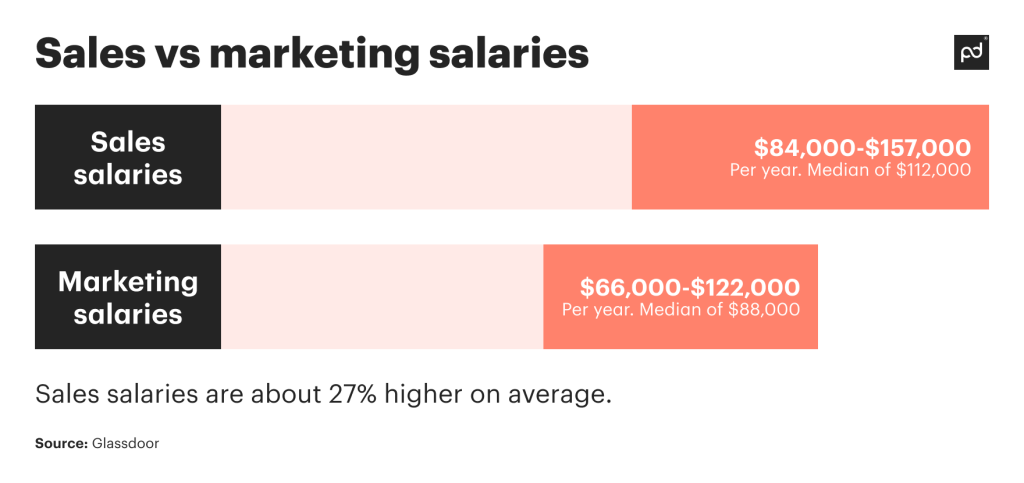Sales and marketing are two terms that are often used interchangeably.
Both business processes are crucial to generating revenue and keeping your company profitable.
In this guide, we’ll cover the basics of sales vs marketing and how you can better align and use them in your business.
Key takeaways
- Sales and marketing are separate domains that work together to grow revenue.
- Marketing funnels drive opportunities to the front and middle of your sales funnels.
- Both sales and marketing use different tools and tactics.
- You can integrate your sales and marketing activities for better optimization and an enhanced customer experience.
- CRM tools and document workflow management software are key to boosting collaboration between the two.
What is sales
Sales is the process of converting a prospect into a paying customer.
A salesperson often works one-on-one with a lead to try and understand their needs.
They’ll typically show the prospect how particular products or services can solve their pain points.
Across several stages in the buyer’s journey, the sales team will push the customer to purchase.
Important stages in the sales funnel include qualifying leads, handling objections, and closing deals.
In summary, sales teams focus on converting opportunities into revenue.
Their goals are relatively short-term, and they’ll often base their efforts on the current sales cycle of a prospect.
What is marketing
Marketing is the process of increasing brand awareness and generating sales opportunities.
Marketers create content, build campaigns, and position brands to appeal to a wide range of customer segments.
Marketing teams will often conduct market research using surveys, case studies, and reports.
This is used to develop ideal customer profiles (ICPs) and buyer personas.
Ongoing performance analysis is also important, helping to better inform strategies for things like advertising and social media campaigns.
Some key marketing objectives are to expand a business’s reach and generate fresh leads.
What’s the difference between sales and marketing
Sales and marketing both aim to generate business revenue.
So, what are some points of differentiation between them?
Their approaches
A key difference between sales and marketing is the approach each one takes.
Marketing efforts broadly increase awareness and improve the company’s reputation.
Teams typically work with the four Ps: product, price, place, and promotion.
Sales teams take a more prospect- or customer-focused approach, tailoring every interaction to the individual.
They identify quality leads, optimize pitches, and use marketing materials.
They also do whatever’s necessary to nudge prospects further down the sales funnel.
All their efforts have one overarching goal: to convert leads into buyers.
Goals
The goal of marketing teams is to create more opportunities, leading to increased revenue in the long term.
They do this by raising visibility and interest in the brand and its products.
Marketers also generate qualified leads, using research to target high-value prospects.
The difference between marketing and sales goals is that the sales team aims to generate revenue right now.
The objective is always conversion. In the middle of the funnel, this might mean getting a prospect to watch a product demonstration or join a presentation.
At the bottom, closers will handle objections and get customers to sign contracts.
Tactics
There are many differences when it comes to sales vs marketing tactics too.
Marketing strategies include:
- Market research on trends and competitors
- Designing well-developed buyer personas
- Segmenting target audiences for personalized messaging
- Building lead magnets and funneling prospects
- SEO content marketing to gain new opportunities for sales
- Omnichannel marketing campaigns to spread brand awareness
Sales team strategies include:
- Identifying opportunities based on market research
- Outreach to prospects via a variety of channels, including email and phone calls
- Attending conferences, seminars, and other networking events
- Scoring marketing qualified leads (MQLs) and filtering out unsuitable prospects
- Maintaining customer relationships
- Leveraging existing networks to generate new opportunities
- Following up on sales pitches and playbooks to resolve customer concerns or questions
As you can see, marketing is about getting people into the sales pipeline; while sales help get prospects to the finish.
Tools and resources
You can also differentiate sales and marketing by the tools and resources each department uses.
Marketers typically use tools to help them with content creation, including graphic design, word processing, and web design.
SEO tools are also used for content marketing, such as producing blog posts or whitepapers.
Marketing teams will often rely on a content management system (CMS) to streamline content generation.
Marketers try to create lead magnets such as e-books and landing pages.
They optimize these materials with conversion rate optimization (CRO) tools. CRO software simplifies things like A/B testing and visitor behavior analysis.
Marketing teams also use business intelligence tools for research, such as monitoring website traffic, and analytics give insights into customer behavior and marketing opportunities.
Sales teams, on the other hand, lean on customer relationship management (CRM) software, such as Salesforce and HubSpot.
They use communication tools like Zoom or Microsoft Teams, too, to host meetings and scheduling tools such as Calendly for presentations and discussions.
Sales teams might also use document workflow software, such as PandaDoc, to provide seamless contract and invoice generation.
Inventory management software can be handy for keeping track of availability and order fulfillment as well.
Who gets paid more – sales or marketing
Salaries vary for sales vs marketing teams. Not all positions or industries are created equal when it comes to pay.
However, sales professionals earn more on average when job titles are identical.
For example, let’s look at a sales director vs a marketing director.
According to salary.com, the median salary of a sales director is $198,452. The median salary of a marketing director is $186,242.
According to Glassdoor:
- Sales salaries range from $84,000-$157,000 per year with a median of $112,000.
- Marketing salaries range from $66,000-$122,00 per year with a median of $88,000.
Using these numbers, sales salaries are about 27% higher on average.

Can a business succeed without sales or marketing
Most small businesses and solopreneurs manage to succeed without dedicated sales or marketing teams.
That doesn’t mean they don’t perform the basics of marketing, however, such as creating brand awareness and generating leads.
They also put on their sales hats to qualify leads and convert them into customers.
So, in answer to this question, you need marketing to generate opportunities.
You also need sales to convert these opportunities into revenue.
In an ideal world, a product would sell itself—but the reality is that this rarely happens.
Ergo, the real question is whether your business can survive without the revenue generated from sales and marketing. For the majority, the answer is “Unlikely”.
How do sales and marketing work together to achieve business goals
Many sales and marketing professionals report misalignment in their strategies.
However, in 2024, we should no longer use the differences between sales and marketing to silo the departments.
So, how can you avoid wasting potential opportunities and revenue?
- Share goals – Align efforts with joint revenue, customer acquisition, and market share goals. This creates shared accountability and encourages teamwork.
- Meet regularly, collaborate often – Host regular meetings with both teams to touch base. Schedule video sessions where remote employees can also attend and report. Delegate liaison officers and collaboration teams and make them responsible for maintaining two-way communication between marketing and sales.
- Use shared email and messaging tools – Use communication apps like Slack and WhatsApp. Create combined sales/marketing channels. Build email groups that allow team members to keep everyone up-to-date and on board.
- Track the right metrics – Use analytics tools for greater transparency and accountability. Track KPIs, including cost per lead (CPL), cost per acquisition, conversion rate, marketing ROI, and sales revenue. Managers should use dashboard reporting to track metrics in real-time.
- Streamline collaborative workflows – In addition, use productivity apps and tools to expedite handoffs. Document workflow software can give everyone access to relevant documents. This makes it easier to share lead qualification sheets, contracts, and marketing intelligence materials.
- Create service level agreements (SLAs). Finally, set expectations and deliverables for each party. Include details such as leads generated per month and conversion rates.
Why is there often friction between sales and marketing departments and how it can be resolved
Friction between sales and marketing is often down to a lack of communication and misalignment.
For instance, if a sales team has a low win rate, they may blame it on poor-quality leads from marketing.
If marketing sees a poor ROI on their campaigns, they’re likely to put it down to the inability of sales to close.
Another example is the importance of pricing in marketing. Different price points appeal to different ICPs and can help position a brand.
However, sales professionals often view lower prices as superior. For them, this means fewer objections and higher win rates.
The reality is that conversion is dependent on marketing and sales working together.
So, use the tactics and tools mentioned in this article to facilitate collaboration between them.
What are some common misconceptions about sales and marketing
Here are a few of the most common misconceptions people have about sales vs marketing.
- Sales and marketing are the same. In fact, each discipline manages different aspects and processes.
- Sales and marketing are independent. Conversely, they’re often seen as separate entities trailblazing their own paths. The reality is that sales and marketing must work together to deliver a truly seamless buying process for customers.
- Marketing and advertising are the same thing. Advertising is only one activity under the marketing umbrella. Marketing also includes research, analysis, content strategy, branding, and more.
- Marketing spends, sales earns. While it can be more difficult to allocate, marketing has its own ROI. Its job is to build awareness and funnel opportunities to the sales team. Without marketing, there’s no sales pipeline and no revenue.
Integrate popular tools with PandaDoc to empower your sales team and increase productivity
The present is the best time to dispel the myths surrounding sales vs marketing. Join your funnels and turn them into a cohesive customer journey.
Only by using the right tools can you successfully align your strategies.
Luckily, PandaDoc is here to help. We can give your team a single source for all their document management needs.
They can even connect popular sales enablement tools, like CRMs and payment processing apps, as well.
Disclaimer
PandaDoc is not a law firm, or a substitute for an attorney or law firm. This page is not intended to and does not provide legal advice. Should you have legal questions on the validity of e-signatures or digital signatures and the enforceability thereof, please consult with an attorney or law firm. Use of PandaDoc services are governed by our Terms of Use and Privacy Policy.

